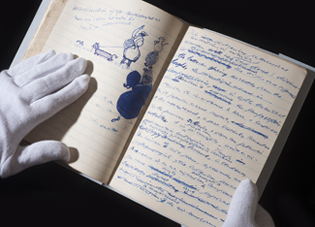£1m Beckett Manuscript goes on public display
Release Date 09 June 2014

A manuscript that offers a unique glimpse into the working mind of one of the world's greatest ever authors and playwrights goes on public display for the first time this week.
The University of Reading is displaying Samuel Beckett's working manuscript of his first published novel, Murphy, after buying it for £962,500 at Sotheby's last year.
The most heavily revised passages provide fascinating evidence about the portions of the text that gave Beckett most trouble. More than a dozen openings are crossed out until the author eventually settled on his famous opening - 'The sun shone, having no alternative, on the nothing new'. Pages also include beautiful jottings, doodles and drawings which show the Nobel-winning author's 'bad' writing days.
At nearly 800 pages long ‘Murphy' is, according to Sotheby's, ‘the most important manuscript of a complete novel by a modern British or Irish writer to appear at auction for many decades'. From October it will be available for scholars and students across the world to study. The University also plans longer-term to digitise and produce a hard copy version to make the manuscript widely accessible to the public.
The six hand-written notebooks, which had been in private hands for the last half century, is now part of the Beckett Collection, the world's largest Beckett archive, based at the University. The manuscript goes on display on Wednesday during Universities Week 2014, a national campaign that this year is focused on raising the profile of university research and its impact on our everyday lives.
Sir David Bell, Vice-Chancellor of the University of Reading, said: "The University of Reading is a world-renowned institution that exists to promote the discovery of new knowledge and understanding. In doing so, it is essential that we offer our scholars, researchers and students access to the very best resources.
"That is why we are delighted to make the wonders of Samuel Beckett's Murphy available to a global audience in the near future. This work, along with other materials held at the University of Reading, provides us with a deeper insight into the thinking of one of the greatest playwrights and authors of all time."
Murphy concerns the main character's attempts to find peace in the nothingness of the ‘little world' of the mind without intrusion from the outside world. It is Beckett's London novel, which he began writing in August 1935 while undergoing intensive psychoanalysis there. It was completed in Dublin in 1936 and unlike many of his other works, which were written in French, was written in English.
Dr Mark Nixon, Director of the Beckett International Foundation at the University of Reading, said: "The University is the centre of Beckett studies worldwide. It is a great privilege for us to be able to publicly display this wonderful manuscript. Murphy provides unparalleled opportunities to learn more about one of the greatest writers in living memory, if not all time.
"The manuscript fills six notebooks with text that is substantially different from the final printed edition in 1938. With its revisions, different colour inks, dated pages and doodles, it is an extraordinarily rich manifestation of Beckett's writing practices. To see the novelist's development of some of the most famous passages in modern literature, gives a unique insight into how he worked at an early stage in his career."
Dr John Pilling, Emeritus Professor of English and European Literature at the University of Reading who is transcribing the manuscript, said: "One, or rather two, details lost during the revision of the manuscript, are to be found at the point where Murphy meets the figure who contributes most to what becomes the ‘only possible' outcome: Beckett initially gave his own first names (Samuel B) to this apparently innocuous figure, and first wrote the scene on the very day the novel tells us that this fateful encounter took place. The final text simply tells us, as if we needed to know, that Murphy himself did not know this."
Completion of Beckett's novel was followed by 40 rejections from publishers before Routledge eventually published the book in 1938. Although it received sympathetic reviews, it was not a success at the time of publication.
The manuscript will be on display at the Museum of English Rural Life. Telephone: 0118 378 8660 or visit the MERL website.
Further information from the University of Reading press office 0118 378 7115/8005
Extra information:
The University of Reading is home to the Beckett International Foundation and the Beckett Collection - the world's largest collection of resources relating to Samuel Beckett as well as many internationally-renowned Beckett scholars, which has meant that the University of Reading has been at the centre of Beckett Studies for over 30 years.
The Beckett Collection archive includes over 600 items of original Beckett material, including manuscript drafts, annotated copies and corrected copies, nearly 500 editions of Beckett's work in more than 20 languages, stage files relating to over 680 productions of Beckett plays, documents and rarely viewed images from the first performance of ‘Waiting for Godot' in Paris in 195